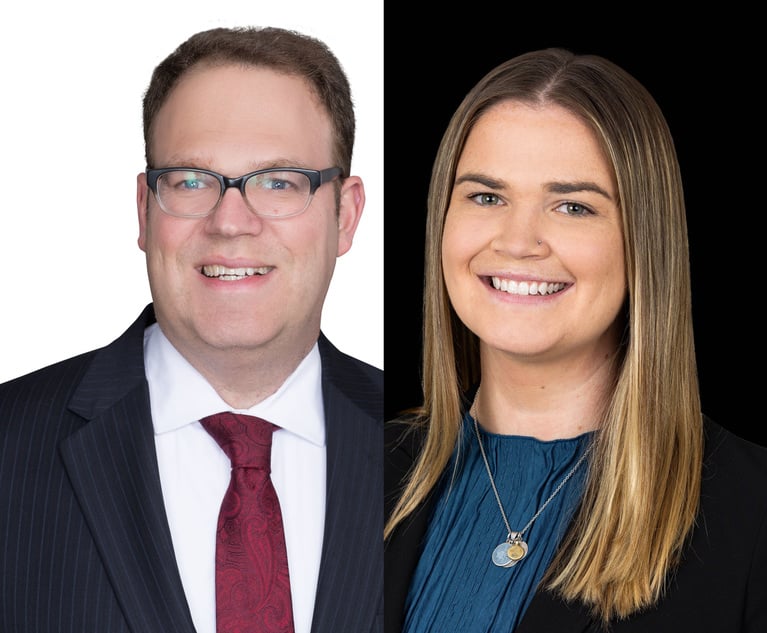The Insurance Maze: How to Maximize Proceeds in Faulty Workmanship Cases
Language is being added to insurance policies to carve out repair and replacement damages.
January 18, 2019 at 12:00 PM
7 minute read
 Shutterstock.com
Shutterstock.com
The vast majority of my time practicing law in New Jersey has been dedicated to issues arising in environmental law, including environmental insurance coverage. However, I have also been involved in pursuing insurance coverage related to other subject matters, including so-called faulty workmanship insurance claims. While my desire in this article is to leap to what I see as the great “open issue” concerning faulty workmanship coverage (are clients really limited to consequential damages?), I should not do that. In order to address this “open issue” practitioners must carefully make their way through the maze to the target.
Before a practitioner will be positioned to make any of the arguments I present below, she needs to follow this path: First, file suit against the insurer in a jurisdiction in which the substantive law is in her client's favor for coverage—for example, New Jersey, not Pennsylvania; second, bring and win a choice of law motion arguing that the substantive law of New Jersey applies to the resolution of the insurance coverage issues (follow Continental Insurance Company v. Honeywell International, 234 N.J. 23 (2018)); third, seek, as part of that complaint, to recoup her attorney fees, as a successful claimant, pursuant to N.J.Ct.R. 4:42-9(a)(6).
If successful in connection with steps one and two, step three can be used in connection with attempts to settle the matter short of trial and maximize insurance recovery. Moreover, if successful in connection with steps one and two, the substantive discussion in the following paragraphs should be of particular interest.
The development of the case law in the faulty workmanship arena in New Jersey parallels that of environmental law. Only in the past two years, however, has the New Jersey Supreme Court been willing to take the wind out of the sails of Weedo v. Stone-E-Brick, 81 N.J. 233 (1979), and its progeny based in large part on the court's prior precedent in the environmental arena. In Cypress Point Condominium Association v. Adria Towers, 441 N.J. Super. 369 (App. Div. 2015), aff'd, 226 N.J. 403 (2016), the court ruled that faulty workmanship constituted an “occurrence” pursuant to the standard comprehensive general liability (CGL) policy in question, thus bringing the claim within the insuring agreement of the policy. It further found that there was “property damage.” The court held that consequential damages (which were the only damages requested by plaintiff) were covered if no policy exclusions applied.
Before Cypress Point insurers in New Jersey routinely denied coverage on all faulty workmanship cases stating that Weedo held that these types of risks could not be insured against. Lower courts were split on the issue, and the Federal District Court of New Jersey was embracing Pennsylvania law and overlooking the fact that between Weedo and today, the business risk exclusions had been replaced for the express purpose of providing coverage.
Bolstered by Cypress, the Appellate Division in Air Master & Cooling v. Selective Ins. Co. of Am., 452 N.J. Super. 35 (App. Div. 2017), overturned decades of precedent in New Jersey and held that every policy in effect when the work was performed by the named insured or any contractors or subcontractors working directly or indirectly on the named insured's behalf, up until the essential nature and scope of damage became known, would be triggered. Before Air Master, courts in New Jersey generally found that the policy in effect when the damage manifested itself would be the only one to respond.
To put Air Master in perspective, this decision means if work was performed on a building in 2003, and damage from water infiltration was not “discovered” until 2010, each policy issued between 2003 and 2010 would be exposed, not just the 2010 policy. This is a tremendous boon to insureds and additional insureds alike and maximizes coverage.
Where things stand today after Cypress and Air Master is that insurance companies that issued these types of CGL policies should pay their share of consequential damages based on this “continuous trigger.”
A share of consequential damages is insufficient.
It is unfortunate that the plaintiff in Cypress either could not or did not press the issue as to whether it was entitled to recoup all of its damages, not just consequential damages. Perhaps a decision was made not to “push the envelope.” In any event, in the construction context, consequential damages generally comprise 25 percent of the damages actually incurred. So, the question remains, how can insureds seek to recoup the remaining 75 percent?
The answer lies, where all of the answers lie, in the policy language itself and its amendments over time. Caution: Before making an argument that all damages can be recouped, you need to (a) obtain an entire copy of the policy, and (b) as painful as it is, read the entire policy. If the policy is a standard CGL policy, it should not mention the phrase “consequential damages” anywhere in it, not even in the so-called “business risk exclusions.” Moreover, if the named insured's subcontractors performed all of the work in question, then the insurance company does not have any hook under any current business risk exclusions to argue that any costs should be carved out unless specific exclusions such as mold exclusions are relevant.
There is, in short, nothing in a standard CGL policy which limits recovery to consequential damages or carves out repair and replacement costs where subcontractors are utilized for the work. Clever insurance company lawyers have simply sold a fable. (See Weedo.) Do we really believe that a contractor expects or intends to damage a house when its subcontractor places the stucco on the house improperly? Why do we carve out repair and replacement of that stucco from coverage when it must be taken out and replaced to fix the house?
Fortunately for insureds, in what can only be described as an attempt to snatch defeat from the jaws of victory, some insurers decided to make it very clear that they will only pay for “consequential damages.” How did they do this? By adding an endorsement amending the term “property damage” to state as follows: “Property damage does not include any loss, cost or expense to correct any defective, faulty or incorrect work performed by you or by any contractors or subcontractors working directly or indirectly on your behalf.”
This language was added to some policies beginning in at least 2009, not to carve out consequential damages from coverage, but to carve out actual repair and replacement damages (i.e., the 75 percent). There was, and is, no reason for the language to exist except to exclude that which must have previously been covered. Therefore, this language should be used to argue that absent this language or other language expressly excluding repair and replacement damages, all damages associated with faulty workmanship performed by subcontractors of the named insured are covered, not just consequential damages.
This is an argument yet to be made, but ripe for the picking.
Martha N. Donovan is co-chair of the Environmental Practice Group at Norris McLaughlin in Bridgewater.
This content has been archived. It is available through our partners, LexisNexis® and Bloomberg Law.
To view this content, please continue to their sites.
Not a Lexis Subscriber?
Subscribe Now
Not a Bloomberg Law Subscriber?
Subscribe Now
NOT FOR REPRINT
© 2025 ALM Global, LLC, All Rights Reserved. Request academic re-use from www.copyright.com. All other uses, submit a request to [email protected]. For more information visit Asset & Logo Licensing.
You Might Like
View All
Dispute Resolution Boards—Getting Real Time Decisions on Construction Projects
7 minute read
Insurer Has No Duty to Defend 'Laidlow' Claims, NJ Supreme Court Says
3 minute read
Construction Worker Hit by Falling Concrete Settles Claims for $2.3M
4 minute read
Trending Stories
- 1'It's Not Going to Be Pretty': PayPal, Capital One Face Novel Class Actions Over 'Poaching' Commissions Owed Influencers
- 211th Circuit Rejects Trump's Emergency Request as DOJ Prepares to Release Special Counsel's Final Report
- 3Supreme Court Takes Up Challenge to ACA Task Force
- 4'Tragedy of Unspeakable Proportions:' Could Edison, DWP, Face Lawsuits Over LA Wildfires?
- 5Meta Pulls Plug on DEI Programs
Who Got The Work
Michael G. Bongiorno, Andrew Scott Dulberg and Elizabeth E. Driscoll from Wilmer Cutler Pickering Hale and Dorr have stepped in to represent Symbotic Inc., an A.I.-enabled technology platform that focuses on increasing supply chain efficiency, and other defendants in a pending shareholder derivative lawsuit. The case, filed Oct. 2 in Massachusetts District Court by the Brown Law Firm on behalf of Stephen Austen, accuses certain officers and directors of misleading investors in regard to Symbotic's potential for margin growth by failing to disclose that the company was not equipped to timely deploy its systems or manage expenses through project delays. The case, assigned to U.S. District Judge Nathaniel M. Gorton, is 1:24-cv-12522, Austen v. Cohen et al.
Who Got The Work
Edmund Polubinski and Marie Killmond of Davis Polk & Wardwell have entered appearances for data platform software development company MongoDB and other defendants in a pending shareholder derivative lawsuit. The action, filed Oct. 7 in New York Southern District Court by the Brown Law Firm, accuses the company's directors and/or officers of falsely expressing confidence in the company’s restructuring of its sales incentive plan and downplaying the severity of decreases in its upfront commitments. The case is 1:24-cv-07594, Roy v. Ittycheria et al.
Who Got The Work
Amy O. Bruchs and Kurt F. Ellison of Michael Best & Friedrich have entered appearances for Epic Systems Corp. in a pending employment discrimination lawsuit. The suit was filed Sept. 7 in Wisconsin Western District Court by Levine Eisberner LLC and Siri & Glimstad on behalf of a project manager who claims that he was wrongfully terminated after applying for a religious exemption to the defendant's COVID-19 vaccine mandate. The case, assigned to U.S. Magistrate Judge Anita Marie Boor, is 3:24-cv-00630, Secker, Nathan v. Epic Systems Corporation.
Who Got The Work
David X. Sullivan, Thomas J. Finn and Gregory A. Hall from McCarter & English have entered appearances for Sunrun Installation Services in a pending civil rights lawsuit. The complaint was filed Sept. 4 in Connecticut District Court by attorney Robert M. Berke on behalf of former employee George Edward Steins, who was arrested and charged with employing an unregistered home improvement salesperson. The complaint alleges that had Sunrun informed the Connecticut Department of Consumer Protection that the plaintiff's employment had ended in 2017 and that he no longer held Sunrun's home improvement contractor license, he would not have been hit with charges, which were dismissed in May 2024. The case, assigned to U.S. District Judge Jeffrey A. Meyer, is 3:24-cv-01423, Steins v. Sunrun, Inc. et al.
Who Got The Work
Greenberg Traurig shareholder Joshua L. Raskin has entered an appearance for boohoo.com UK Ltd. in a pending patent infringement lawsuit. The suit, filed Sept. 3 in Texas Eastern District Court by Rozier Hardt McDonough on behalf of Alto Dynamics, asserts five patents related to an online shopping platform. The case, assigned to U.S. District Judge Rodney Gilstrap, is 2:24-cv-00719, Alto Dynamics, LLC v. boohoo.com UK Limited.
Featured Firms
Law Offices of Gary Martin Hays & Associates, P.C.
(470) 294-1674
Law Offices of Mark E. Salomone
(857) 444-6468
Smith & Hassler
(713) 739-1250






